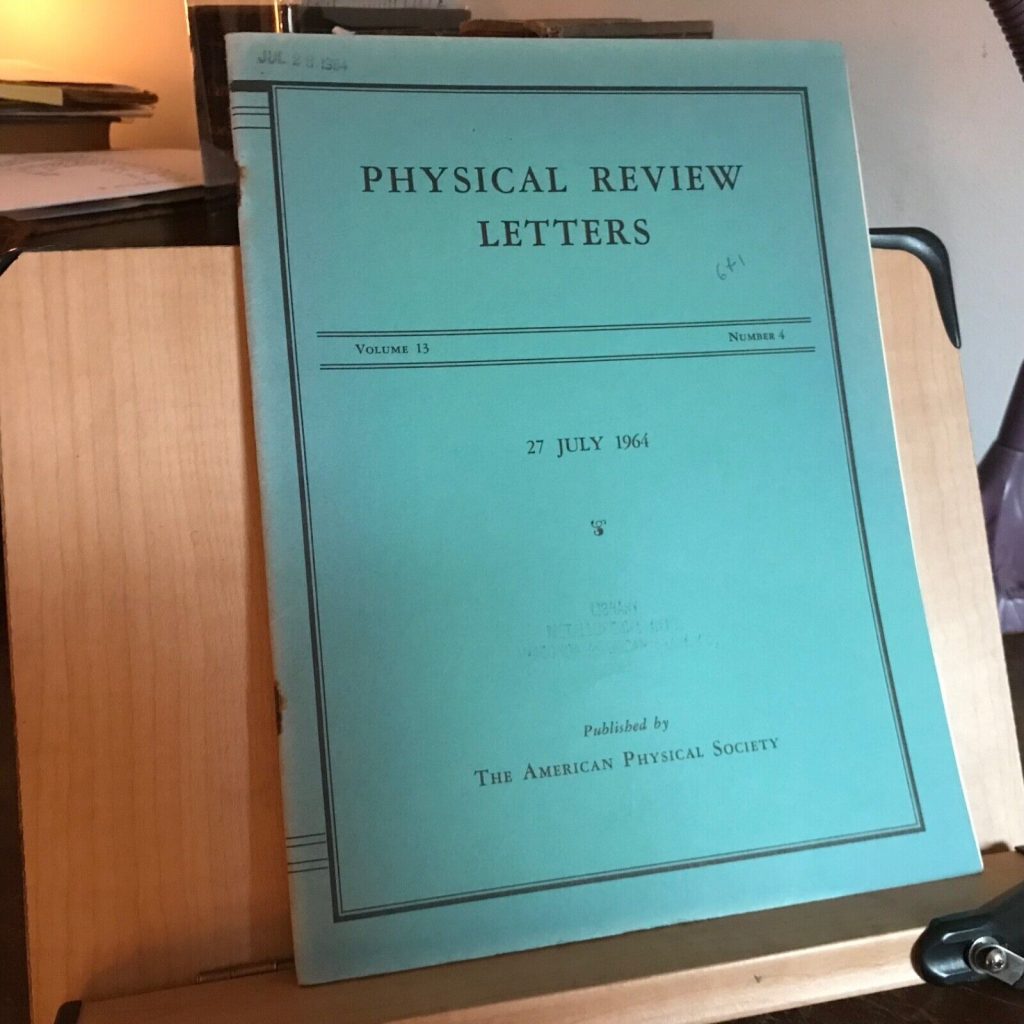Physical Review Letters
Physical Review Letters (PRL) is a highly esteemed scientific journal that covers all aspects of physics research. It’s published by the American Physical Society (APS), a leading organization dedicated to advancing physics research and education.
PRL is known for its rigorous peer-review process and its focus on publishing groundbreaking, high-impact research in physics. It serves as a platform for the rapid dissemination of important findings across various subfields of physics, including particle physics, condensed matter physics, astrophysics, quantum mechanics, and many others.
Key features of Physical Review Letters include:
- High Impact: PRL is considered one of the most prestigious journals in physics, and publication in PRL is often seen as a significant achievement for researchers due to its impact factor and reputation.
- Conciseness and Innovation: Articles in PRL are typically brief, focusing on concise presentations of novel and impactful research findings. The emphasis is on innovation, novelty, and the potential significance of the discoveries.
- Rapid Publication: PRL prioritizes rapid publication, aiming to disseminate groundbreaking research quickly within the scientific community.
- Broad Scope: The journal covers a wide range of topics within physics, encouraging interdisciplinary research and collaboration.
Researchers, physicists, and institutions worldwide value publications in Physical Review Letters for their contribution to advancing the understanding of fundamental physics and for shaping the trajectory of scientific inquiry within the field.

What is a physical review letter?
A Physical Review Letter (PRL) refers to a specific type of scientific publication found in the journal “Physical Review Letters,” which is published by the American Physical Society (APS). These letters are concise, high-impact articles that report significant, novel, and original research findings in the field of physics.
Physical Review Letters is known for its stringent peer-review process and its focus on publishing cutting-edge research across various disciplines within physics. Articles published as PRLs are typically brief and succinct, emphasizing the innovation, significance, and potential impact of the discoveries presented.
PRLs often highlight groundbreaking research, new theoretical developments, experimental breakthroughs, or novel observations that contribute to advancing our understanding of fundamental physics. Due to the journal’s prestige and impact factor, publication in Physical Review Letters is highly regarded within the scientific community and can significantly influence the direction of research in a particular area of physics.
How prestigious is Physical Review Letters?
Physical Review Letters (PRL) is considered one of the most prestigious and influential scientific journals in the field of physics. Its reputation stems from several factors:
- High Impact Factor: PRL consistently maintains a high impact factor, indicating that the research published in the journal is widely cited by other scientific papers. This reflects the significant influence and importance of the articles published in PRL within the scientific community.
- Rigorous Peer Review: The journal upholds a rigorous peer-review process, ensuring that only high-quality, original, and impactful research articles are accepted for publication. This stringent evaluation contributes to the journal’s reputation for excellence.
- Breadth of Coverage: PRL covers a wide range of physics subfields, from particle physics and cosmology to condensed matter physics, quantum mechanics, astrophysics, and more. This breadth allows for a diverse range of groundbreaking research to be published.
- Focus on Innovation: Articles in PRL often present innovative and significant findings, whether they are experimental breakthroughs, new theoretical developments, or novel observations. The emphasis on innovation and potential impact sets PRL apart as a leading platform for cutting-edge research.
- International Recognition: PRL’s global reach and influence make it highly regarded by physicists and researchers worldwide. Being published in PRL is often seen as a hallmark of achievement and recognition within the scientific community.
Due to these factors, publication in Physical Review Letters is considered prestigious and is often a significant milestone for researchers in the field of physics. Being featured in PRL can elevate the visibility of a scientist’s work and contribute to advancing their career within the scientific community.
What is PRL in research?
“PRL” typically refers to “Physical Review Letters,” which is a renowned scientific journal published by the American Physical Society (APS). In the context of research, “PRL” commonly stands for this specific journal.
Physical Review Letters (PRL) is a platform that publishes high-impact, concise, and influential research articles in the field of physics. It covers a broad spectrum of physics subfields, including but not limited to particle physics, condensed matter physics, astrophysics, quantum mechanics, and more.
In scientific research, referring to work as being published in “PRL” signifies that the research has undergone a rigorous peer-review process and has been deemed of significant importance within the scientific community. Articles published in PRL often feature groundbreaking research, novel theoretical developments, experimental breakthroughs, or innovative observations that advance our understanding of fundamental physics concepts.
For researchers, having their work accepted and published in Physical Review Letters can be considered a prestigious accomplishment, as it reflects recognition and validation of their findings by the scientific community. The prominence of PRL within the field of physics makes it an influential platform for disseminating impactful research and shaping the trajectory of scientific inquiry.

How do you write a PRL?
Writing a paper for Physical Review Letters (PRL) requires careful attention to several key aspects due to the journal’s emphasis on concise, high-impact research. Here’s a general guide on how to approach writing a paper intended for PRL:
- Choose a Significant Research Topic: Select a research topic that addresses an important, innovative, or impactful problem within the field of physics. Your work should contribute something novel and substantial to the existing body of knowledge.
- Concise and Clear Presentation: PRL articles are typically brief, so focus on clarity and conciseness. Present your research in a clear, straightforward manner, using concise language without unnecessary jargon.
- Structure Your Paper:
- Abstract: Write a clear and concise abstract that summarizes your research, methods, key findings, and implications.
- Introduction: Provide necessary background information, state the research question or objective, and outline the significance of your work.
- Methodology or Approach: Describe your experimental methods, theoretical framework, or computational approaches.
- Results: Present your findings, experiments, data, or theoretical results clearly and succinctly.
- Discussion: Interpret your results, discuss their significance, and relate them to existing literature or theories. Highlight the novelty and impact of your findings.
- Conclusion: Summarize the key findings, their implications, and potential future directions.
- Emphasize Innovation and Significance: PRL seeks innovative research that pushes the boundaries of knowledge in physics. Clearly highlight the novelty, significance, and potential impact of your work.
- Be Precise and Rigorous: Ensure your methods are sound, results are accurate, and conclusions are supported by evidence. Rigorous scientific methodology is crucial in PRL.
- Use Figures and Tables Effectively: Use visual aids such as figures, graphs, and tables to enhance the presentation of your data and results. Ensure they are clear, informative, and support your narrative.
- Seek Clarity and Accessibility: Make your paper accessible to a broad audience of physicists. Avoid overly technical language or excessive detail that might hinder readability.
- Review and Revise: Revise your paper multiple times, checking for coherence, clarity, accuracy, and compliance with PRL’s guidelines. Solicit feedback from colleagues or mentors to improve the quality of your manuscript.
- Adhere to PRL Guidelines: Familiarize yourself with the specific formatting and submission guidelines provided by Physical Review Letters. Adhering to these guidelines is essential for a successful submission.
Keep in mind that PRL values originality, significance, and succinctness. Crafting a paper for PRL involves presenting your research in a manner that highlights its importance and potential impact within the field of physics.

How long is a physical review letter?
Physical Review Letters (PRL) articles are known for their brevity compared to articles in many other scientific journals. Typically, the length of a paper published in PRL is limited to approximately four printed journal pages.
To put this into perspective, a PRL paper typically contains around 3500 to 4000 words, including all sections such as the abstract, introduction, methodology, results, discussion, and references. This word count is an approximate guideline, and the actual length may vary slightly depending on the content and formatting.
Due to the strict length constraints, authors submitting papers to PRL must ensure that their research is presented concisely and clearly. It’s crucial to focus on the most significant aspects of the study, provide concise descriptions of methods and results, and emphasize the key findings and their significance within the limited space available.
What is the acceptance rate of Physical Review Letters?
Specific acceptance rates for journals like Physical Review Letters (PRL) were not publicly disclosed by the American Physical Society (APS), the organization that publishes PRL.
PRL is known for its rigorous peer-review process and high standards for publication. The journal receives a large number of submissions containing cutting-edge research in various physics disciplines. Due to the stringent review process and limited space available for publication, the acceptance rate for PRL is typically low.
However, exact acceptance rates can fluctuate over time and vary based on numerous factors, including the volume and quality of submissions received, changes in editorial policies, and the evolving landscape of research within different subfields of physics.
While the acceptance rate for PRL may not be explicitly published or easily accessible, the journal’s reputation for excellence, the high impact of its published articles, and its role as a platform for groundbreaking physics research make acceptance into PRL a highly competitive and significant achievement for physicists and researchers.

Is Physical Review Letters impact factor?
Yes, Physical Review Letters (PRL) has a high impact factor, which is a measure used to assess the influence and significance of a scientific journal within its field. The impact factor is calculated based on the average number of citations received by articles published in the journal within a specific time frame, usually over the past two years.
PRL is widely recognized for its high impact factor, indicating that the research articles published in the journal are frequently cited by other scientific papers. This signifies the significant influence and importance of the research published in PRL within the physics community.
While the specific impact factor for PRL can vary from year to year, it consistently remains among the highest impact factor journals in the field of physics. The high impact factor of PRL reflects the journal’s reputation for publishing groundbreaking, high-quality research that significantly contributes to advancing the understanding of fundamental physics concepts.
What is the H index of Physical Review Letters?
The H-index is a metric that measures both the productivity and impact of a scientist’s or a journal’s scholarly publications. It’s determined by the number of papers a researcher has published and the number of citations those papers have received.



